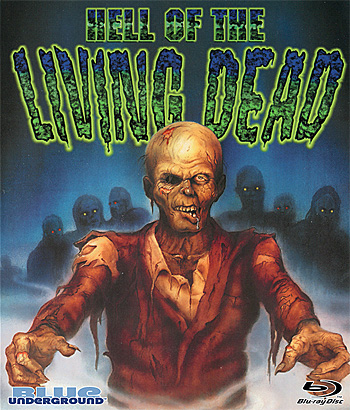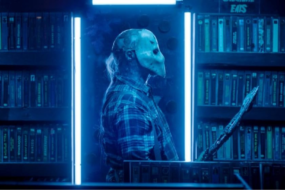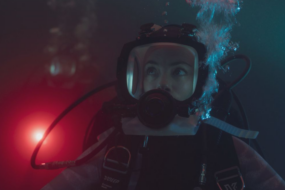
Not Rated | Color | 99 minutes
Directed by Bruno Mattei
Also Known As: Night of the Zombies
WARNING: THIS REVIEW CONTAINS SOME MINOR SPOILERS!
It’s been over four years since the world lost James “Doc Terror” Harris, one of the greatest champions of Italian Horror cinema that I had ever known. To honor his memory, I decided to review a fright flick from the boot-shaped land of pizza and pasta. But as the saying goes, “the road to Hell is paved with good intentions,” and (unfortunately for me) I must’ve added a new paving stone when I selected Bruno Mattei’s notorious HELL OF THE LIVING DEAD.
I first discovered HELL several decades ago thanks to a review on BadMovies.Org, under its alternate title NIGHT OF THE ZOMBIES. As a teenage horror enthusiast, I eagerly soaked up everything the genre had to offer. I had just started this website and was working nights at Suncoast Motion Picture Company, surrounded by a gaggle of horror nerds. Inevitably, I stumbled across a VHS tape of NIGHT OF THE ZOMBIES and reviewed it.
Revisiting my old [terrible, eye-searing] review, it’s clear I absolutely abhorred Bruno Mattei’s zombie disasterpiece. This makes me wonder why I own it on Blu-ray (I keep telling myself it’s because RATS: NIGHT OF TERROR is also included on the disc), and why I thought it’d be a great idea to revisit it. Why? WHY?! WHY DID I PUT MYSELF THROUGH THIS TORTURE AGAIN?!?! ARRRGGH!
HELL OF THE LIVING DEAD starts by establishing a factory/research center filled with technicians and scientists in white lab coats. Dubbed a “Hope Center,” this secret research facility is ground zero for a program codenamed “Operation Sweet Death.” As scientists run tests on their equipment (randomly pushing colorfully lit buttons on a large console), two employees in protective suits conduct a safety check. They discover a dead rat which caused a small gas leak. Before they can report their findings, the rat returns to life and attacks!
The zombie rodent kills one of the workers, who, during the scuffle, blows open a valve, unleashing a green-hued gas that fills the Hope Center, turning anyone exposed into ravenous zombies. The film then shifts to a hostage crisis in Barcelona, Spain, where a group of “eco-terrorists” have barricaded themselves with hostages. Their demand? Shut down all Hope Centers globally! Local police secure the perimeter while a squad of Interpol agents infiltrates the building.
Led by Lieutenant Mike London (Jose Gras), the commandos quickly neutralize the terrorists before any hostages are harmed. The dying leader of the terrorists warns of impending death and doom. Suddenly, the agents find themselves in New Guinea. Wait, what? How did they get halfway across the world?!
Normally, I wouldn’t nitpick something this trivial, but there’s almost no transition leading to this change of venue. Typically, you’d have a brief scene explaining the relocation, but here, they just awkwardly appear in New Guinea, which is jarring.
Soon after arriving, Mike London and his team encounter news reporter Lia Rousseau (Margie Newton) and her cameraman Max (Gabriel Renom). After their fellow travelers are devoured by zombies, the reporters and Interpol agents travel deeper into the jungles to escape. Along the way, they encounter stock footage and a tribe of natives who take them in after Lia jogs into their village wearing only body paint.
Their respite is short-lived. After a chaotic zombie raid, they flee to an abandoned plantation but are attacked again, resulting in Osborne’s death. The survivors reach a beach by daybreak, board a raft, and head towards the Hope Center seen in the film’s opening.
Inside the facility, they are quickly picked off by zombies until only Lia and Vincent remain. Just before they are cornered, Lia reveals the true purpose of the Hope Center before meeting her gruesome end. The film concludes with a young couple being ambushed by zombies elsewhere, suggesting the undead menace is now global.
HELL OF THE LIVING DEAD was one of fifteen films Bruno Mattei and Claudio Fragasso collaborated on between 1980 and 1990. While Mattei is credited as the director, Fragasso reportedly shot much of the film and directed the cast because Mattei was more adept at editing footage. According to Fragasso, there was an agreement where Mattei said, “We work together, but I’m going to be credited as director.”
But perhaps that worked out best for Fragasso because HELL OF THE LIVING DEAD is a chore to sit through and remains one of my least favorite Italian zombie films. From its terrible pacing to the blatant overuse of stock footage, every frame is dripping with glorious ineptitude!
Initially conceived as a mashup of Romero’s DAWN OF THE DEAD and 1973’s SOYLENT GREEN, the premise was cut back due to lack of funds. The SWAT-style jumpsuits worn by the leads were tailored from dumpster materials, the bulk of the extras were migrant workers and gypsies, and stock footage padded the runtime.
Fragasso wanted Goblin to compose new music for the film, but budget constraints led to a soundtrack cobbled together from various sources, including Goblin’s tracks from DAWN OF THE DEAD, Joe D’Amato’s BUIO OMEGA, and a bit of Luis Bacalov’s score from BLOOD AND DIAMONDS. This eclectic mix of music works surprisingly well and gives the film a much-needed boost.
The cast does their best with the nonsensical script, with standout performances from Margie Newton and Franco Garofalo. Margie’s news reporter has the two most memorable moments in the film, while Franco shines as the increasingly frantic Zantoro. From yelling at his comrades for wasting ammo to playing “keep away” with zombies, Zantoro is the character you root for.
The film’s makeup and gore effects, crafted by Giuseppe Ferranti and Antonio Balandín, include some memorable moments of onscreen carnage, such as exploding zombie skulls and a cat emerging from an old woman’s corpse.
While HELL OF THE LIVING DEAD has a strange charm, I cannot in good conscience recommend it to casual viewers. It’s strictly for fans of Italian horror cinema, bad zombie flicks, and die-hard Bruno Mattei and Claudio Fragasso enthusiasts. My generous rating reflects its unique, albeit flawed, appeal.






